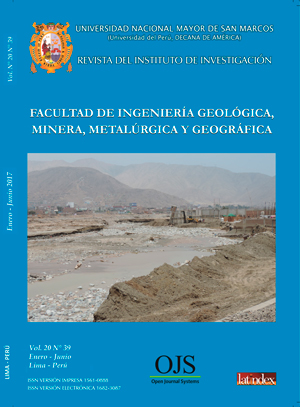Diagnosis of water use and Discharging of Effluents Liquids in Peru (2013-2015)
DOI:
https://doi.org/10.15381/iigeo.v20i39.14175Keywords:
water use, discharging, effluents, wastewater, reuse, wastewater treatment, economic retribution, authorizationsAbstract
In Peru, the management of water use and discharges are regulated by Water National Authority, which gives the right of use and discharging in sustainability conditions and economic retribution. The number of discharging authorizations between 2013 and 2015 was 529; and 21 for reuse. The points of authorized discharging were 686. The total authorized volume for discharging was 1802 hm3. And 16 hm3 for reuse. The sub-sectors that had discharging authorization between 2013 and 2015 were the mining (261 authorizations and 913 hm3 of discharging), fishing (87 authorizations and 24 hm3 of discharging), hydrocarbon (74 authorizations and 86 hm3 of discharging), industries (34 authorizations and 180 hm3 of discharging), sanitation (18 authorizations and 429 hm3 of discharging), electricity (31 authorizations and 330 hm3 of discharging) and agriculture (3 authorizations and 0,4 hm3 of discharging).
Due to the availability of economic retribution data, it is analyzed for the year 2014. In that year were assigned authorizations for consumption of 23 816,60 cubic hectometers (hm3) and authorizations for use (without consumption) of another 37 544,82 hm3. The economic retribution of that were paid for discharging used for water use was about 82 million of soles, and 42 million of soles of discharging.
The volume of authorized water for consumption and energetic use in 2014 was 60 757 hm3, equivalent to 60 times the average level of Rimac river, while the total authorized discharging (including the energy) was 188 hm3 the same year, equivalent to 20 % of average level of Rimac river. So, we can deduce that a) There’s an important number of discharging which don’t count with authorization because the water hasn’t been treated or don’t keep the permissible maximum limits and b) as the population and the productive sectors consume big volumes of water, therefore, they make a huge quantity of residual waters too. However, this information must be counted.
The article 32.1 of the General Environmental Law, law 28611, promulgated on October 15th, 2015, defines the permissible maximum limits as the concentration of elements, substances, physical, chemicals and biologicals parameters, that characterize an effluent or an emission that being exceed causes or may cause health damage, to the human well-being and environment. The competent authority legally required its compliance. According to the parameter, which the concentration is related, it may be expressed in maxima, minima, and ranges.
Downloads
Published
Issue
Section
License
Copyright (c) 2017 Leonor Carmen Méndez Quincho, Pedro Melitón Ramos Matías, Oscar Felipe Arce Cruzado

This work is licensed under a Creative Commons Attribution-NonCommercial-ShareAlike 4.0 International License.
AUTHORS RETAIN THEIR RIGHTS:
a. Authors retain their trade mark rights and patent, and also on any process or procedure described in the article.
b. Authors retain their right to share, copy, distribute, perform and publicly communicate their article (eg, to place their article in an institutional repository or publish it in a book), with an acknowledgment of its initial publication in the Rev. Inst. investig. Fac. minas metal cienc. geogr.
c. Authors retain theirs right to make a subsequent publication of their work, to use the article or any part thereof (eg a compilation of his papers, lecture notes, thesis, or a book), always indicating the source of publication (the originator of the work, journal, volume, number and date).






